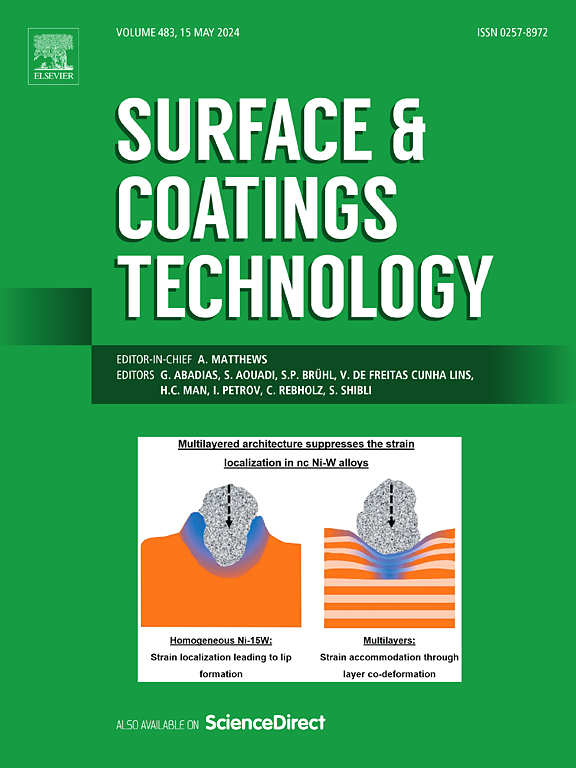High-temperature oxidation behavior of TaNbTiZrW alloy coatings on W-based surfaces
IF 6.1
2区 材料科学
Q1 MATERIALS SCIENCE, COATINGS & FILMS
引用次数: 0
Abstract
Tungsten, the monolithic metal with the highest melting point in nature, has become the material of choice for plasma-facing first walls in nuclear fusion and for lining components of rocket engine nozzles and throats due to its excellent properties. However, it still faces great technical challenges in practical applications due to its limited oxidation resistance. In this study, a TaNbTiZrW multi-component alloy coating system was fabricated using double glow plasma surface alloying (DGPSA) technology by optimizing temperature parameters. The experimental results indicate that the coatings exhibit a typical BCC solid solution structure with a dense, homogeneous microstructure and strong adhesion to the substrate. The coating exhibits excellent mechanical properties. The surface hardness of the prepared coating significantly increased, with the maximum Vickers hardness under a 0.5 N load reaching 1364 HV, which is three times that of the substrate. Friction and wear tests demonstrate that the coating possesses outstanding wear resistance, achieving a minimum wear rate of 7.41 × 10−7 under identical test parameters—two orders of magnitude lower than that of the W substrate. The high-temperature oxidation behavior of the coating at 800 °C in air exhibited good oxidation resistance, with the minimum mass gain after 10 h of oxidation being 8.841 mg/cm2. During long-term oxidation, the coating with optimal oxidation performance followed a cubic oxidation kinetic law, exhibiting an oxidation rate exponent of 3.59. The coating formed a dense oxide layer consisting of single oxides and composite oxides during the oxidation process. Mechanistic analysis indicates that TiO2 generated from Ti effectively suppresses the formation of detrimental oxides, while the incorporation of Zr not only accelerates the initial formation of protective oxide layers but also promotes the rapid generation of complex metal oxides. In addition, the formation of TiO2 and ZrO2 significantly reduces the overall thermal expansion coefficient of the alloy coating. The synergistic effects of these multi-component elements significantly improve the oxidation resistance of the coating, offering a novel technical pathway for surface modification of tungsten-based materials.
TaNbTiZrW合金涂层在w基表面的高温氧化行为
钨是自然界熔点最高的单片金属,由于其优异的性能,已成为核聚变等离子体面第一壁和火箭发动机喷嘴和喉管内衬部件的首选材料。然而,由于其抗氧化能力有限,在实际应用中仍面临很大的技术挑战。本研究通过优化温度参数,采用双辉光等离子体表面合金化(DGPSA)技术制备了TaNbTiZrW多组分合金涂层体系。实验结果表明,该涂层具有致密、均匀的微观结构,具有较强的附着力,是典型的BCC固溶体结构。该涂层具有优异的机械性能。制备的涂层表面硬度显著提高,0.5 N载荷下最大维氏硬度达到1364 HV,是基体的3倍。摩擦磨损试验表明,该涂层具有优异的耐磨性,在相同的试验参数下,其最小磨损率为7.41 × 10−7,比W基体低两个数量级。涂层在800℃空气中的高温氧化行为表现出良好的抗氧化性能,氧化10 h后的最小质量增益为8.841 mg/cm2。在长期氧化过程中,氧化性能最佳的涂层遵循立方氧化动力学规律,氧化速率指数为3.59。涂层在氧化过程中形成由单一氧化物和复合氧化物组成的致密氧化层。机理分析表明,由Ti生成的TiO2有效抑制了有害氧化物的形成,而Zr的掺入不仅加速了保护性氧化层的初始形成,而且促进了复合金属氧化物的快速生成。此外,TiO2和ZrO2的形成显著降低了合金涂层的整体热膨胀系数。这些多组分元素的协同作用显著提高了涂层的抗氧化性,为钨基材料的表面改性提供了新的技术途径。
本文章由计算机程序翻译,如有差异,请以英文原文为准。
求助全文
约1分钟内获得全文
求助全文
来源期刊

Surface & Coatings Technology
工程技术-材料科学:膜
CiteScore
10.00
自引率
11.10%
发文量
921
审稿时长
19 days
期刊介绍:
Surface and Coatings Technology is an international archival journal publishing scientific papers on significant developments in surface and interface engineering to modify and improve the surface properties of materials for protection in demanding contact conditions or aggressive environments, or for enhanced functional performance. Contributions range from original scientific articles concerned with fundamental and applied aspects of research or direct applications of metallic, inorganic, organic and composite coatings, to invited reviews of current technology in specific areas. Papers submitted to this journal are expected to be in line with the following aspects in processes, and properties/performance:
A. Processes: Physical and chemical vapour deposition techniques, thermal and plasma spraying, surface modification by directed energy techniques such as ion, electron and laser beams, thermo-chemical treatment, wet chemical and electrochemical processes such as plating, sol-gel coating, anodization, plasma electrolytic oxidation, etc., but excluding painting.
B. Properties/performance: friction performance, wear resistance (e.g., abrasion, erosion, fretting, etc), corrosion and oxidation resistance, thermal protection, diffusion resistance, hydrophilicity/hydrophobicity, and properties relevant to smart materials behaviour and enhanced multifunctional performance for environmental, energy and medical applications, but excluding device aspects.
 求助内容:
求助内容: 应助结果提醒方式:
应助结果提醒方式:


